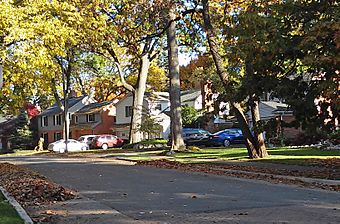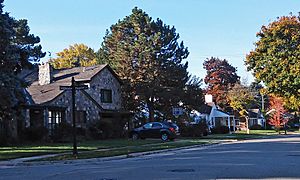Springwells Park Historic District facts for kids
Quick facts for kids |
|
|
Springwells Park Historic District
|
|
 |
|
| Location | Rotunda Dr., the Michigan Central Railroad line, and Greenfield and Eastham Rds. Dearborn, Michigan |
|---|---|
| Architect | Giffels & Vallet, Inc., and L. Rossetti |
| Architectural style | Colonial Revival |
| NRHP reference No. | 14001046 |
| Added to NRHP | April 28, 2015 |
The Springwells Park Historic District is a special neighborhood in Dearborn, Michigan. It's known for its beautiful homes and green spaces. This area was officially recognized as a historic place in 2015 because of its unique history and design. It's located near Rotunda Drive, the Michigan Central Railroad line, and Greenfield and Eastham Roads.
How Springwells Park Began
A long time ago, this land was part of a "ribbon farm." This type of farm was long and narrow, stretching along the Rouge River. In 1914, a man named Gustav Zanger bought the land. He hoped to give it to the Detroit Zoo.
However, the zoo decided to build in a different city, Royal Oak. So, in 1927, Henry Ford offered to buy the property. Ford then gave the land to the Ford Foundation. In 1938, the foundation decided to turn the land into a neighborhood for homes.
Building the Neighborhood
The entire area was planned as one big project. It was divided into five smaller sections, called subdivisions. The first section, which included a shopping center, was mapped out in 1939.
Building homes started in 1940. By 1941, three more sections were mapped out. About 60% of the homes were built before World War II began. After the war, another 30% of the homes were finished. The last homes were built between 1960 and 1988. One of the five original sections was never built as part of this neighborhood. It later became a fancy golf course community.
What Springwells Park Looks Like
The Springwells Park neighborhood has streets that gently curve and follow the land. Many streets end in cul-de-sacs, which are dead-end streets with a round turn-around area. There are lots of old, tall trees throughout the neighborhood. You'll also find small parks hidden in the middle of some blocks.
The buildings here include single-family homes, duplexes (homes for two families), townhouses, and apartment buildings. There's also a shopping center. All the buildings share a similar style called Colonial Revival. This means they look like older American colonial homes. They also use similar building materials on the outside.
Most of the homes and duplexes are one, one-and-a-half, or two stories tall. They all have Colonial Revival details and roofs that come to a point, called gable roofs. The outside walls are made of brick, stone, wood siding (clapboard), or a mix of these materials. Most homes have garages attached to them.
The neighborhood has different types of single-family homes. Some are like "Cape Cods," which are one-and-a-half stories. Others are two-story homes with a main entrance in the middle. There are also one-and-a-half-story cottages and one-story ranch houses.
The duplexes are mostly in the northern part of the neighborhood. They also vary in shape but use similar styles and materials. Many are two-story brick homes. The townhouse buildings are all similar, with parts of the building sticking out and other parts set back. They have two-story red brick walls and hip roofs, which are roofs that slope down on all four sides. The apartment buildings are shaped like a "U" and have entrances in the middle with small towers (cupolas) on top.



